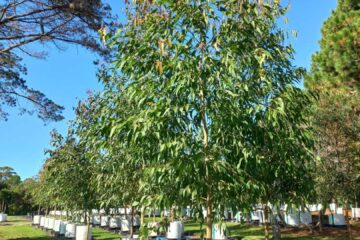Dr Ed Gilman on the Critical Importance of Moisture
PLANTING AND ESTABLISHMENT OF LARGE LANDSCAPE TREES
Our instruction sheet “Make Sure Your New Trees Thrive” emphasises the critical importance of keeping the rootball moist.
Dr. Edward Gilman, the highly-regarded Professor of Environmental Horticulture at the University of Florida, specialises in research concerning nursery production, quality, planting, establishment, watering and pruning of landscape trees. Some years ago he conducted seminars in Australia which many of us attended.
To reinforce our general “Moisture!” message, we encourage you to read the following summary of his findings on this subject as reported in “Australian Horticulture” at that time.
“He said the ultimate aim at planting was to encourage rapid root penetration and development. Plantings should be followed up with a rigorous after-care program lasting two years, or until tree establishment. Proper watering was identified as the single most important maintenance task to be done. Dr. Gilman cited research showing plants that receive frequent irrigation after transplanting establish their roots in the surrounding soil, and become drought-tolerant, sooner than those trees receiving only periodic (once every seven-to-ten days) irrigation.
‘Research indicates that root growth is most prominent on trees where soil is kept constantly moist and does not undergo regular drying out. The objective for the landscape manager is to establish an irrigation program that keeps soil in the root ball moist,’ Dr. Gilman said.
He said this was in stark contrast to the typical street-tree irrigation scenario, whereby trees often go from receiving intensive watering at the wholesale nursery to receiving a rate of irrigation that barely sustains survival.”
Almost without exception, it is our experience that recently planted trees showing signs of stress are lacking adequate moisture in the rootball. This is a particular problem with spring and summer plantings – especially during months, such as a typical October, when hot north-westerly winds attack soft new spring growth.

